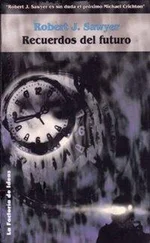“Why not?”
“Vic calls it ‘entanglement inertia,’ and, I’ve got to say that it’s a revolutionary-enough discovery that it might get her the Nobel on her own. See, a single electron will decohere rapidly, falling out of superposition, but, for whatever reason, the countless trillions of superpositioned electrons in a given brain are locked together in a way that defies quantum theory, and so probabilistic laws apply. At any moment, any one of them might wish to decohere back to the classical state, but, unless a majority simultaneously want to, it doesn’t happen. We’ve got computer simulations that show the tipping point never comes, at least not normally. Oh, an external force—an anesthetic, for instance—can cause the superposition to decohere, but without something like that, the superposition never collapses. It just keeps on going on.”
I made an impressed face. “Has she published yet?”
Kayla shook her head. “It’s out for peer review at Neuron.”
“Sounds like a great paper.”
“I’ll send you a preprint. But it’s only the first of several papers; she and I also have one coming up in Physics of Life Reviews.”
I took a sip of my own wine. “Oh? What about?”
“Well, Penrose proposed that each tubulin macromolecule has a single two-lobed hydrophobic pocket with just one free electron. But he also offhandedly remarked that there might actually be multiple hydrophobic pockets, each with its own electron. And that’s exactly what Vic and I have found: there are actually three hydrophobic pockets in each tubulin macromolecule.”
“Okay.”
“And all the tubulin macromolecules in a given brain are quantally entangled, meaning collectively they’re all in the same state: the combination of superpositioned and classical electrons is the same in every tubulin in the brain of a given individual.”
“Ah.”
“That means that each person is in one of eight possible conditions: all three pocketed electrons in the classical-physics state; all three in superposition; or six possible combinations of one or two electrons in the classical state and the remaining ones in superposition.”
“Very cool.”
“Thanks. Now, we don’t think it matters which electrons are in superposition and which aren’t; electrons, like all subatomic particles, are fungible. So that means there are really only four states not eight: no electrons in superposition, any one of the three in superposition, any two in superposition, and all three in superposition. In other words, there’s the classical-physics state, plus three states with quantum superposition: Q1, Q2, and Q3.”
“Got it.”
“And it’s the Q2 state that caused me to look you up; that’s where my research dovetails with yours. I ran a couple of hundred volunteers through Victoria’s beamline—the test doesn’t take long—and found that everybody’s got at least one electron in superposition. Nobody was in the classical-physics state; everyone was either Q1, Q2, or Q3. And the three cohorts are each successively smaller, a 4:2:1 ratio, each group half the size of the one before it. In round numbers, sixty percent of our test subjects had only one electron in superposition; thirty percent—half as many—had any two in superposition; and about fifteen percent had all three in superposition.”
“I suppose it’s like juggling,” I offered. “Easy to keep one ball in the air, harder with two, and a bitch with three.”
“Yeah, that’s our thinking, too. Assuming those ratios hold true for the entire human race, if you think of Earth’s population as seven billion people—it’s really more like 7.7, but for convenience’s sake let’s assume abstinence-only sex education actually worked, and round down—that means there are four billion in the first cohort, two billion in the second, and just one billion in the third.”
“Right.”
“Anyway,” said Kayla, “I was curious if there were any psychological differences between the cohorts, and so I administered a standard five-factor-model personality measure on each subject and— bada-bing! —all our Q2s had scores that correlated with psychopathy.”
“Ah,” I said, finally getting it. “You came up with a triad suggestive of psychopathy: low conscientiousness, low agreeableness, high extraversion.”
“Exactly! Got essentially the same results when I tried HEXACO, too, so we moved on to the Lilienfeld Psychopathic Personality Inventory and the Hare Psychopathy Checklist, and found an almost perfect correlation between psychopathy and having any two of the three electrons in superposition. Didn’t matter which two—that’s how we confirmed the fungibility notion—but if you had two out of three, you were a psychopath.” She raised a hand, palm out. “Not necessarily a violent one, mind you. You were just as likely to be one of those Hare calls ‘a snake in a suit,’ a ruthless businessperson. Still, it’s a clear-cut relationship, just like your microsaccades thing.”
“You said about thirty percent of your test group were Q2s?”
“Yup, and evenly split between men and women.”
“My microsaccades test shows the same percentage and gender balance. Did you get the kind of flak I did about that being a much higher prevalence of psychopathy than is generally assumed?”
She smiled. “We cited you in our paper on that very point, but, yeah, we’re expecting the reviewers from Physics of Life to challenge us on it.”
I nodded. As I’m sure Kayla knew, most older estimates put the prevalence of psychopathy at between one and four percent of the general population of men, and about a tenth of that among women. But those values were due to sampling problems. Take Kent Kiehl, one of Hare’s last grad students, who did the first-ever scans of psychopaths’ brains—great work, that. He did his initial studies at the University of British Columbia, where, with the extraordinary cooperation of the Canadian Department of Corrections, he was able to routinely transfer violent criminals who had scored high on the Hare Checklist to a hospital where they could be scanned by fMRI; the precautions taken against the prisoners escaping were worthy of a Hollywood film.
But when Kent was lured to Yale with a sweetheart offer—he asked for double the salary his colleagues in Canada were getting and was told, “Oh, we can do better than that”—he immediately became frustrated. He’d hoped to work with psychopaths at large in the New Haven community: people with criminal records but now released from prison. But he found— duh! —that psychopaths weren’t good about keeping appointments for scientific experiments, and those rare times they did show up, they were often too drunk or too uncooperative to be of any use.
Anyway, one of the chapters of Kent’s book The Psychopath Whisperer begins by baldly declaring, “Fact: There are over twenty-nine million psychopaths worldwide.” If you flip to the endnote, it turns out he reached that figure by assuming the percentage of psychopaths found in prisons accurately reflected the prevalence of psychopathy in the population as a whole. But the ones behind bars are just the ones dumb enough to get caught; with their skills at manipulation and deception, psychopaths almost certainly are captured at a rate much lower than that of normal people—my pal Devin Becker notwithstanding.
Likewise, Kent claims that there are ten times as many male psychopaths as females. Why? Well, see, he says, there are ten times as many male psychopaths in prison as females ones—which is true, but there are also ten times as many male left-handers in prison, and male redheads, and males who like anchovies on their pizza—simply because there are ten times as many men behind bars as women.
Читать дальше











